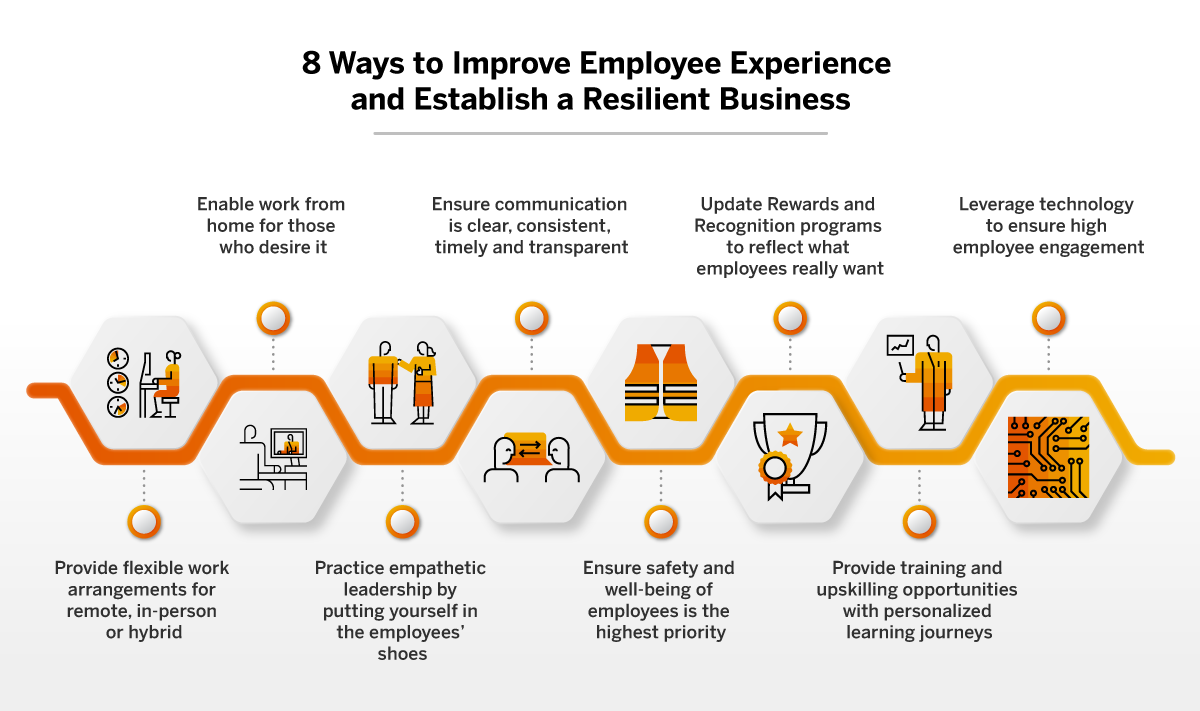The pandemic laid bare the frailties in the global business landscape, forcing leaders and organizations to accept and act upon change. Now that it has become clear that COVID-19 may not be the last of disruptions that the world might have to contend with, businesses are looking to engineer change in operations, infrastructure, processes and policies, and crisis responses. As companies re-evaluate their continuity plans, business resilience is the new catchword in the business world.
What is Business Resilience?
Business resilience is an organization’s ability to adapt its operations, absorb stress and ensure business continuity in the face of adverse situations or change. It is about having the foresight to recognize risk factors and causes of disruption and plan for them. Of course, many businesses currently practice risk management in some manner – mostly to better understand and mitigate exposure to specific, well-known hazards. Resilience must also encompass unidentified threats, as well as the adaptations and transformations that a corporation must do to absorb and even leverage environmental stress.
Contrary to popular perception, contingency plans for business resilience do not mean having largescale organizational resources and ample cash reserves to weather disruption. It is more about adapting than just response. And as old business ways collapse, technology has helped give a head start to organizations invested in building business resilience. Adopting lean, digital-first agile processes has helped them transform legacy business models, reinvent the way they work and reset their business strategy. One way to do so is by leveraging SAP Business ByDesign, which delivers pre-built processes for everything from finance and sales to product management and purchasing on a single, unified solution.
However, while crafting business resilience plans, aspects like data recovery, securing IT systems, alternative modes of working, etc occupy a prime place in the minds of most leaders. The critical importance of employees to business continuity is often overlooked. Resilient businesses with loyal and productive employees have a higher chance of bouncing back after a crisis or unforeseen incident. Clearly, a business is only as resilient as its people — and this calls for outstanding employee experiences.
What is Employee Experience?
Employee experience can be defined as the continuing relationship between an employee and an organization. It begins right from the interview and onboarding process and continues to be shaped with every interaction that happens after that along the employee life cycle. It encompasses all that defines and influences an employee’s role in the company — such as the workspace, the role of managers, benefits offered, rewards and recognition, health and well-being and much more.
Positive employee experiences lead to the employee delivering positive customer experiences, thus creating a virtuous cycle that feeds back into employees’ sense of achievement and purpose.
Businesses with robust employee engagement practices have a workforce that is invested in achieving organizational goals; one that is more likely to identify with the ‘one team’ vision driving business goals. This alignment between the employees’ identity and that of the company leads to improved productivity and profits and lower employee turnover.
Employee experience — the unseen factor in business resilience
A black swan event such as the pandemic has thrown the definition of employee experience out of the window, to be replaced with one that fits the new normal.
As businesses shifted from survival to recovery and resilience mode, it became clear that redesigning employee experience is of paramount importance. Most businesses are either planning to or already replacing or refreshing services and product mixes to ride out the challenges of the chaotic past two years. To do that, it is essential to create conducive internal conditions, which translates to redesigning the employee experience to nurture creativity, a sense of purpose and fulfillment.
This prioritization of the human factor at the workplace is evident in a recent study conducted by Forrester Consulting on behalf of Elastic. The survey of CIOs and IT leaders in 10 countries revealed that 60% of IT organizations are investing in improving employee experience to support remote workforce productivity and performance. To amplify the impact on employee experience, 57% of IT leaders are collaborating more closely with their HR counterparts.

How can a business create better experiences for employees?
At the end of the day, companies that don’t develop new and existing personnel at the same rate as their technology are unlikely to have the capabilities they need to advance digital transformation. This will result in their competitive advantage dwindling.
Here’s how organizations can make the most of their talent and establish truly resilient companies.
- Provide flexible work arrangements
After an extended live experiment in working remotely, the craving for flexibility will be greater once employees return to physical office environments. Organizations that offer flexible working models — whether remote, in-person or hybrid — and the necessary support to make the transition easier have a better chance of retaining or attracting a skilled workforce. Flexible work arrangements provide access to a larger talent pool and create a more diverse and inclusive workplace that fosters creativity and increases employee loyalty. This, in turn, can add to business resilience.
Some of the ways in which flexible work arrangements can be brought about at the workplace are job sharing, flexible working hours, compressed workweeks and flexible rostering.
- Enable work from home for those who desire it
Employers and employees have more or less perfected the work-from-home model. While employees are now reaching the pre-pandemic productivity levels and producing quality work from their home offices, remote working has cut the fatigue and sensory overload that accompanies the travel to and from the office.
Because of the reduction in physical office space, distributed work models can save a lot of money, but establishing and maintaining a work culture and sustaining cooperation can be difficult. Successful firms have deployed efficient remote access and collaboration technologies that have made the employee experience flexible, standardized, secure, and simple to use while also allowing for increased productivity. Such a strategy can amplify employee engagement, productivity and retention, and will benefit the business in the long term.
- Practice empathetic leadership
The importance of compassionate leadership is felt keenly now, more than ever. Empathy was always considered a key trait of a good leader, who puts people at the center of business or technological decisions, from a work, personal or wellness level. When CEOs, managers, team leaders and others in decision-making roles put themselves in employees’ shoes, they are able to make informed decisions that have positive implications for the workforce. This enhances employee well-being, boosts their morale, increases their loyalty and sets in motion the wheels for business resilience and growth.
- Ensure communication is clear and consistent
As work models, expectations and processes churn rapidly, it is vital that communication channels between employees and the management remain open and clear. Employees should have regular updates on how the organization is moving forward. They need clarity on how the company will address issues related to workplace health, safety and well-being, flexible work models, etc. Timely and transparent communication will engender employee trust and build employee and business resilience.
- Ensure safety and well-being of employees
The COVID-19 pandemic and the resultant uncertainty and fear it created has affected the physical and mental health of employees across the world. While each individual responds to stress in unique ways, it is established that stress affects employees’ ability to empathize, be open-minded, engage with the organization, take up challenging tasks, and to learn and grow. Thus, the health, safety and well-being of employees should be the highest priority for all organizations as workplaces reopen. While some industries with high-risk jobs have long prioritized safety, Covid-19 mandates that all businesses, regardless of location, have safety practices in place to protect their employees and show that they care.
- Update R&R programs to reflect what employees really want
Companies need to revisit their Rewards and Recognition (R&R) programs considering the new reality. They must figure out what is more likely to motivate their employees, since monetary rewards may not hold the same sheen as before. Experiences are more important to new-age workers. Thus, personalized rewards aligned to individual preferences and lifestyle choices are more likely to appeal to them. Even acknowledging the dedication and hard work of employees through small acts of everyday appreciation can go a long way to make them feel valued.
By using technology such as virtual working platforms and remote collaboration applications, companies can give their R&R strategies a digit redesign to deliver an employee experience that fosters pride and a sense of belonging.
- Provide training and upskilling opportunities
Building the most effective, resilient workforce necessitates not just new hiring but also the development of existing talent. As the way we do things changes because of digitalization, businesses have a big potential to make the most of their existing staff.
Many of the duties that today’s employees perform are monotonous and unfulfilling. However, if advanced machines take over most of the monotonous, repetitive work, employees can be reallocated and upskilled to more satisfying occupations that provide them with greater happiness.
Training and learning initiatives are important for the career development and growth of employees. Identifying unique skills or traits such as initiative, creativity, and problem-solving, and creating training programs to sharpen them, will benefit both the employer and the employee. Personalized learning journeys boost the self-esteem of employees and their feelings of inclusion and belonging. Future-ready organizations must invest in upskilling and reskilling initiatives in transferable skills that cut across domains, functions and businesses to remain competitive.
- Leverage technology to ensure high employee engagement
Employee engagement is better in organizations that provide effective collaboration tools and integrated digital workspaces to access apps. With a majority of the workforce staying connected to the firm for longer periods of time now, compared to before the epidemic, these measures allow improvement in employee productivity.
AI, machine learning and cloud-based tools have proven to be highly efficient for multi-regional teams to communicate, collaborate and work together. For example, SAP Business ByDesign is a single cloud ERP solution that connects every function across a company with proven best practices and in-depth analytics to build business resilience.
Companies that use digital analytics and data tools to identify and fulfill employee needs are more likely to succeed in the new normal. SAP BusinessObjects Business Intelligence suite of solutions can assist leaders make informed decisions with access to real-time insights on a single, scalable platform — leading to standout employee experiences and business transformations.

Conclusion
To summarize, resilience is required for firms to sustain global competitiveness since it equips them to recover from any organizational setback. It is tough to build a resilient workforce, but with proper planning and execution, as well as trust and open communication, one can succeed.
During the epidemic, firms that prioritized robust processes, agile decision-making, technological investments, and nimble organizational structures survived and even prospered. Those that redesigned work had lower attrition rates, improved employee experience, engagement, and productivity.
With the support of technological tools, data and people analytics, organizations can mine employee data, analyze it and come up with actionable insights and solutions to create employee experiences that are meaningful. Pivoting to an employee-centric approach when adopting technology will establish a work environment that fosters productivity and engagement.
To find out how to accelerate your journey to becoming digitally resilient and setting yourself up for success in the long run, learn how you can integrate SAP Employee Experience Management into your operations. Listen, understand and respond to employee needs and experience gaps to ensure your employees, and your organization, stay resilient and productive in the long run.



